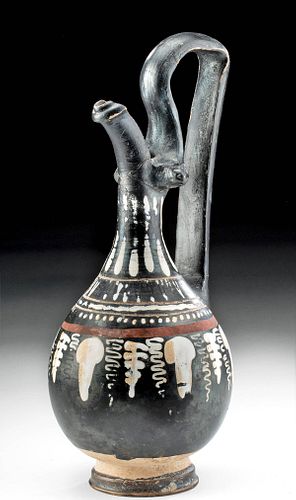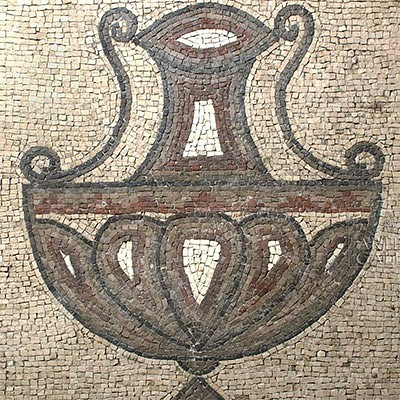Gnathian Pottery Beaked Oinochoe
Lot 54
About Seller
Artemis Gallery
686 S Taylor Ave, Ste 106
Louisville, CO 80027
United States
Selling antiquities, ancient and ethnographic art online since 1993, Artemis Gallery specializes in Classical Antiquities (Egyptian, Greek, Roman, Near Eastern), Asian, Pre-Columbian, African / Tribal / Oceanographic art. Our extensive inventory includes pottery, stone, metal, wood, glass and textil...Read more
Categories
Estimate:
$600 - $900
Absentee vs Live bid
Two ways to bid:
- Leave a max absentee bid and the platform will bid on your behalf up to your maximum bid during the live auction.
- Bid live during the auction and your bids will be submitted real-time to the auctioneer.
Bid Increments
| Price | Bid Increment |
|---|---|
| $0 | $25 |
| $300 | $50 |
| $1,000 | $100 |
| $2,000 | $250 |
| $5,000 | $500 |
| $10,000 | $1,000 |
| $20,000 | $2,500 |
| $50,000 | $5,000 |
| $100,000 | $10,000 |
| $200,000 | $20,000 |
About Auction
By Artemis Gallery
Sep 22, 2020
Set Reminder
2020-09-22 12:00:00
2020-09-22 12:00:00
America/New_York
Bidsquare
Bidsquare : Antiquities - Egypt, Greece, Italy, Near East
https://www.bidsquare.com/auctions/artemis-gallery/antiquities---egypt-greece-italy-near-east-5663
Featuring Egyptian, Greek, Roman, Etruscan & Near Eastern art. If you love the classics, this is the sale for you. All artifacts offered for sale have been legally acquired, are legal to sell and are guaranteed to be as described. In-house shipping for your convenience. Artemis Gallery info@artemisgallery.com
Featuring Egyptian, Greek, Roman, Etruscan & Near Eastern art. If you love the classics, this is the sale for you. All artifacts offered for sale have been legally acquired, are legal to sell and are guaranteed to be as described. In-house shipping for your convenience. Artemis Gallery info@artemisgallery.com
- Lot Description
Magna Graecia, southern Italy, near present day Ignazia, ca. 340 to 320 BCE. An attractive polychrome beaked oinochoe with zoomorphic maskettes at the upper end of the handle and an elaborate decorative program delineated via the Gnathian technique with fugitive red, white, and yellow pigments. The body presents a lovely register of grape clusters alternating with sinuous vines, perfect for celebrating the god of wine, Dionysos; above are striated, wavy, and dotted decorative bands followed by a register of ovalo motifs and a wide register of vertical petaloid frets adorning the neck of the vessel. An elegant example of Gnathian ware, replete with the utmost artistry and technique. Size: 3.375" W x 8.125" H (8.6 cm x 20.6 cm)
Gnathia ware is named for the site where it was first discovered - the Apulian site of Egnathia. The black glaze ware is traditionally decorated with floral motifs in red, white, and/or yellow hues. Scholars believe that its production most likely was centered around Taras, with primary workshops in Egnathia and Canosa. The quantity and quality of Greek colonial Apulian potters increased significantly following the Peloponnesian War when Attic exports dramatically decreased. Apulian artistry demonstrates influences of Ionian (Athenian, Attic) conventions, as well as Doric (western colonial Greek) styles, with a palpable native Italian aesthetic.
Provenance: ex Estate of Eldert Bontekoe, Pegasi Numismatics, Ann Arbor, Michigan USA acquired before 2000
All items legal to buy/sell under U.S. Statute covering cultural patrimony Code 2600, CHAPTER 14, and are guaranteed to be as described or your money back.
A Certificate of Authenticity will accompany all winning bids.
We ship worldwide and handle all shipping in-house for your convenience.
#158328Repairs to handle and beaked spout with losses to the break lines and one maskette as shown and areas of touch up to the black pigmentation. Expected surface wear commensurate with age, with nicks to peripheries and some losses to pigmentation though much remains.Condition
- Shipping Info
-
All shipping is handled in-house for your convenience. Your invoice from Artemis Gallery will include shipping calculation instructions. If in doubt, please inquire BEFORE bidding for estimated shipping costs for individual items.
-
- Buyer's Premium



 EUR
EUR CAD
CAD AUD
AUD GBP
GBP MXN
MXN HKD
HKD CNY
CNY MYR
MYR SEK
SEK SGD
SGD CHF
CHF THB
THB















